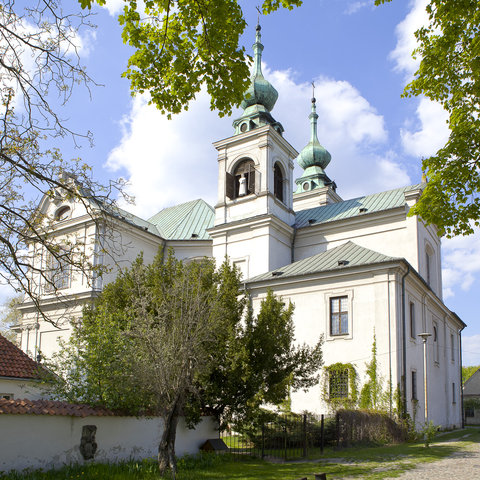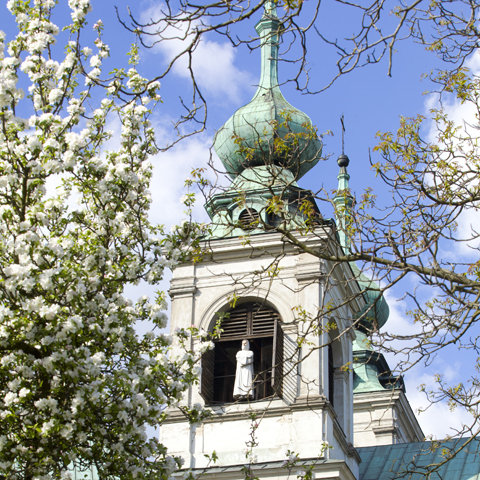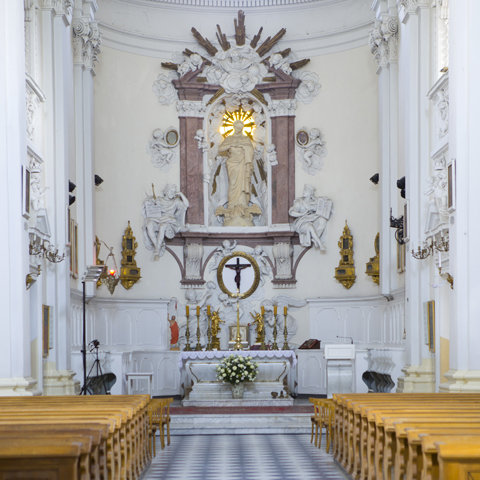Composers / Fryderyk Chopin / Places catalog
Bielany, Camaldolese monastery
When the brilliant scholar, philosopher and reformer Stanisław Staszic, president of the Warsaw Society for the Friends of Learning, died, on 20 January 1826, his coffin was put on public display at the Society’s headquarters. This imposing building, now known as Staszic Palace, had only been erected a few years earlier. Varsovians attended the grand funeral on 26 January en masse, as a token of their appreciation.
In his book on Staszic, Jerzy Sikora wrote that ‘Literally the whole of Warsaw came pouring out onto the streets from the early morning, especially outside the building of the Society for the Friends of Learning on Krakowskie Przedmieście, where a huge crowd gathered. Fortunately, the weather was favourable. The mud on the pavements was set by a light frost and covered with a white mantle of snow.
‘Members of the Society bore the coffin on their shoulders to Plac Saski (Saxon Square), where the academicians took possession of it and carried it to Bielany, changing every half hour. They refused to surrender it to the artisans and merchants, who so desired it, even for a moment. The clergy played a large part in the funeral, with Bp Adam Prażmowski leading the funeral procession to Plac Zamkowy (Castle Square). The coffin was followed by an empty, six-horse hearse, with the carriages of Viceroy Józef Zajączek and Speaker of the Senate, Stanisław Zamojski, a former pupil of Staszic immediately behind. Last came a variety of vehicles, especially sleds, as the streets were covered in snow. Tens of thousands of people accompanied the procession on foot to the final resting place of one of Poland’s greatest sons. The enormous crowd followed the entire funeral route. Offices, shops and factories were closed all over the city. The funeral became a demonstrative celebration – an expression of a deep and widespread mourning occasioned by the passing of a man who had become a symbol of the greatness of our nation during his lifetime.
‘The sermon at the funeral service was given by the vice-chancellor of the university, Wojciech Szweykowski, who stressed the tremendous services Staszic had rendered society, his exceptional modesty and extraordinary generosity for great and noble purposes.
‘The speech over the open grave was given by Fryderyk Skarbek, a professor at the university and a friend of the deceased. It was hard for him to make his way through the packed crowd that encircled the grave, so students carried him to his makeshift lectern on their shoulders. The professor finished his brilliant funeral address with an appeal to the young people to follow the example of the great citizen and patriot that was Staszic […].
‘Barely had Prof. Skarbek finished his funeral address when students began to rip the shroud to pieces and tear the handles and metal plating from the coffin. They all wanted something to treasure as a precious memory. Fryderyk Chopin, a 16-year-old youth at the funeral, similarly managed to pluck off a piece of the precious shroud.’
Chopin himself described the entire event in a letter to Jan Białobłocki of 12 February that year: ‘I don’t write to you about Staszic, because I know that you have sufficient information about his rich-humble funeral, with all possible details, from the newspapers and couriers. I will only mention to you that the Academicians carried him from Holy Cross Church all the way to Bielany, where he had wished to be buried, that Skarbek made the oration over the grave, that they stripped his coffin out of love and enthusiasm, and that I, too, have as a memento a piece of the pall with which the bier was covered, finally, that 20 thousand people accompanied the body the whole way. A few decisive verbal skirmishes took place along the way, now with some merchants, who made insistent claims to carry the remains of the Honourable Gentleman, now with other civilian persons, who likewise wished to take the coffin away from the members of the Academy, who were resisting manfully.’
-

Camaldolese monastery. Phot. Waldemar Kielichowski.
-

Camaldolese monastery. Phot. Waldemar Kielichowski.
-

Camaldolese monastery. Phot. Waldemar Kielichowski.
-

Intorior of Camaldolese monastery. Phot. Waldemar Kielichowski.